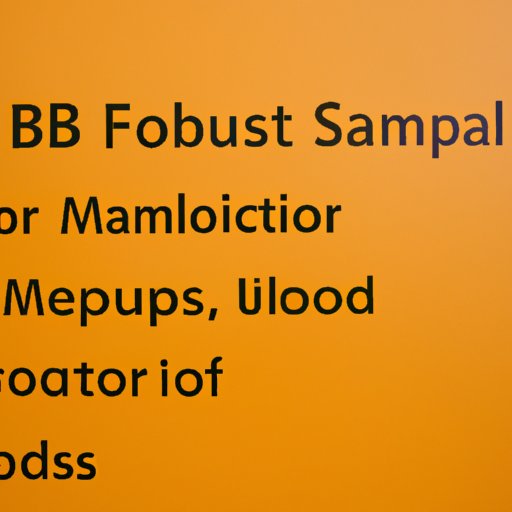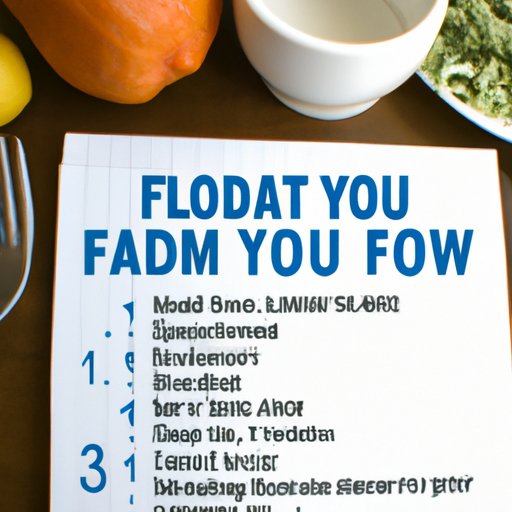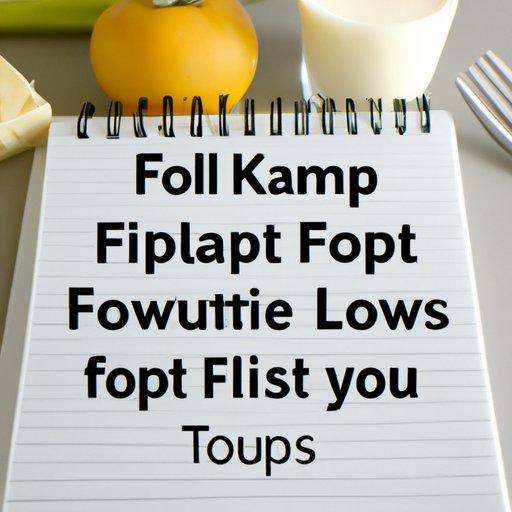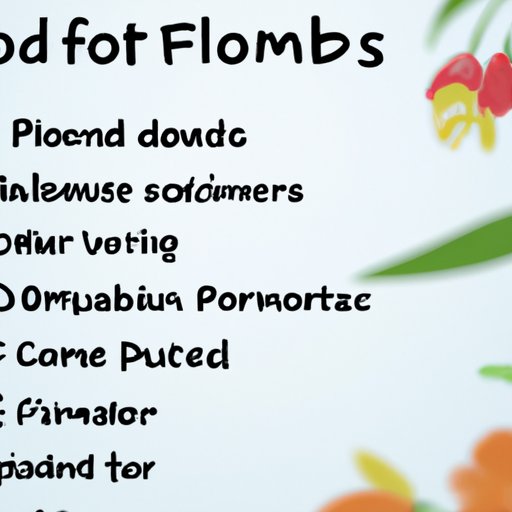Introduction
The Low FODMAP diet is a special type of dietary plan designed to help individuals with irritable bowel syndrome (IBS) manage their symptoms. It is based on the idea that certain types of carbohydrates, known as FODMAPs, can trigger digestive issues in those with IBS, such as bloating, gas, and abdominal pain. By avoiding or limiting intake of these particular carbohydrates, individuals may be able to reduce their IBS symptoms.
Definition of Low FODMAP Diet
FODMAP stands for Fermentable Oligosaccharides, Disaccharides, Monosaccharides and Polyols. FODMAPs are short chain carbohydrates found in many common foods. They are poorly absorbed in the small intestine, which can lead to increased water retention, gas production, and other digestive issues in some people.
The Low FODMAP diet was developed by researchers at Monash University in Australia and involves eliminating high FODMAP foods from your diet. These foods include dairy products, certain fruits and vegetables, wheat, legumes, and artificial sweeteners. The goal of the diet is to reduce the amount of FODMAPs in your diet so that you can better manage your IBS symptoms.
Benefits and Challenges of Low FODMAP Diet
The Low FODMAP diet has been found to be effective in reducing IBS symptoms in up to 75% of sufferers. Studies have shown that following a low FODMAP diet can significantly reduce abdominal pain, bloating, and other common IBS symptoms. Additionally, the diet may help prevent constipation, diarrhea, and other digestive issues.
However, there are some challenges associated with the Low FODMAP diet. It can be difficult to follow, since it requires a significant lifestyle change. Additionally, it can be hard to know which foods contain FODMAPs, and the diet can be expensive, since many of the approved foods are more costly than their high FODMAP counterparts.

Overview of Low FODMAP Diets for IBS Sufferers
Symptoms of IBS
Irritable bowel syndrome (IBS) is a chronic condition characterized by abdominal pain, cramping, bloating, and changes in bowel habits. Common IBS symptoms include constipation, diarrhea, frequent urges to go to the bathroom, and feeling full after eating only a small amount of food. While the exact cause of IBS is unknown, it is believed to be related to an imbalance of bacteria in the gut, food intolerance, and stress.
How Low FODMAP Diet Helps
The Low FODMAP diet helps to reduce the amount of FODMAPs in the diet, which can help to reduce IBS symptoms. This is because FODMAPs are not absorbed well in the small intestine, and can increase water retention and gas production in some people. By limiting intake of these particular carbohydrates, individuals may be able to reduce their IBS symptoms.
Advantages and Disadvantages
The Low FODMAP diet has been found to be very effective in reducing IBS symptoms in up to 75% of sufferers. Additionally, the diet is relatively easy to follow, since it is based on avoiding certain foods rather than counting calories or tracking macronutrients. However, the diet can be difficult to stick to, since it requires a significant lifestyle change, and it can be hard to know which foods contain FODMAPs.

How to Begin a Low FODMAP Diet
Step-by-Step Guide
If you’re considering starting a Low FODMAP diet, the first step is to speak to your doctor or nutritionist. They can help you understand the diet and make sure it is safe for you to start. Once you’ve spoken to your healthcare provider, you can begin the process of eliminating FODMAPs from your diet.
The best way to do this is to start with a “low FODMAP elimination diet.” This involves eliminating all high FODMAP foods for a period of time (typically 2-6 weeks) and then slowly reintroducing them one at a time to identify which foods trigger your IBS symptoms. This process should be done under the guidance of a qualified nutritionist or dietitian.
Working with a Nutritionist or Dietitian
It is important to work with a qualified nutritionist or dietitian when starting a Low FODMAP diet. They can help you understand the diet, create a meal plan, and provide support and guidance throughout the process. Working with a professional can help you get the most out of the Low FODMAP diet and ensure that you are getting all the nutrients you need.
Common Mistakes to Avoid
When starting a Low FODMAP diet, it is important to avoid some common mistakes. For example, it is important to remember that just because a food is low in FODMAPs does not mean that it is healthy. Additionally, it is important to remember that not all FODMAPs are bad, and some can actually be beneficial for gut health. Finally, it is important to remember that the Low FODMAP diet is not a long-term solution, but rather a way to identify which foods trigger your IBS symptoms.

Low FODMAP Recipes: Delicious Meals to Try
Breakfast Ideas
There are many delicious Low FODMAP breakfast recipes that you can try. Some ideas include oatmeal cooked with almond milk and topped with berries, a smoothie made with banana, almond milk, and chia seeds, and scrambled eggs with spinach and mushrooms. Additionally, you can make a breakfast wrap with turkey and avocado, or a frittata with potatoes, bell peppers, and cheese.
Lunch and Dinner Ideas
For lunch and dinner, there are many creative and delicious Low FODMAP recipes to choose from. Some ideas include grilled salmon with quinoa and steamed vegetables, roasted chicken with potatoes and broccoli, and tacos with ground beef, lettuce, and tomatoes. Additionally, you can make a stir fry with tofu and vegetables, a burrito bowl with rice and beans, or a veggie burger with sweet potato fries.
Snack Ideas
Snacking on a Low FODMAP diet doesn’t have to be boring. Some tasty snack ideas include hummus and carrots, celery and peanut butter, and apples and yogurt. Additionally, you can make trail mix with nuts and dried fruit, or have some hard-boiled eggs. If you’re craving something sweet, try making some muffins with almond flour or baking a batch of cookies with coconut oil.
A Shopping Guide to Low FODMAP Foods
List of Low FODMAP Foods
When shopping for Low FODMAP foods, it is important to know which foods are allowed on the diet. Generally speaking, most fresh fruits and vegetables are low in FODMAPs, as well as lean proteins, gluten-free grains, nuts, and seeds. Additionally, certain dairy alternatives, such as almond milk and coconut yogurt, are low in FODMAPs. It is also important to read labels carefully, as some processed foods may contain hidden sources of FODMAPs.
Tips for Finding Low FODMAP Products
When shopping for Low FODMAP products, it is important to look for products labeled “Low FODMAP” or “FODMAP Friendly.” Additionally, it is important to read labels carefully and look for any ingredients that may be high in FODMAPs. Finally, it is helpful to keep a list of approved Low FODMAP foods handy when shopping, so that you can quickly check if a product is allowed on the diet.
Foods to Avoid on a Low FODMAP Diet
High FODMAP Foods
When following a Low FODMAP diet, it is important to avoid high FODMAP foods such as dairy products, certain fruits and vegetables, wheat, legumes, and artificial sweeteners. Additionally, some processed foods may contain hidden sources of FODMAPs, so it is important to read labels carefully.
Other Foods to Avoid
In addition to high FODMAP foods, it is important to avoid foods that can trigger IBS symptoms, such as caffeine, alcohol, spicy foods, and fried foods. Additionally, it is important to limit intake of highly processed foods, as they can be high in sugar, fat, and sodium.

Tips for Successfully Following a Low FODMAP Diet
Keeping a Food Diary
One of the best ways to successfully follow a Low FODMAP diet is to keep a food diary. This will help you track which foods trigger your IBS symptoms and make it easier to identify which foods to avoid. Additionally, keeping a food diary can help you stay motivated and accountable.
Eating Out
Eating out can be challenging on a Low FODMAP diet. However, it is possible to find restaurants that offer Low FODMAP options. When dining out, it is important to ask questions about the ingredients in dishes and avoid anything that contains high FODMAP ingredients. Additionally, it is helpful to have a list of approved Low FODMAP foods handy.
Managing Social Situations
It can be difficult to manage social situations when following a Low FODMAP diet. To make it easier, it is helpful to bring your own food to events or potlucks. Additionally, it is important to remember that everyone’s needs are different, and it is okay to politely decline certain foods or drinks if they don’t fit into your diet.
Staying Hydrated
Staying hydrated is essential when following a Low FODMAP diet. It is important to drink plenty of fluids throughout the day, such as water, tea, and low FODMAP juices. Additionally, it is important to avoid drinks that contain caffeine, alcohol, or artificial sweeteners, as these can trigger IBS symptoms.
Conclusion
The Low FODMAP diet is a special type of dietary plan designed to help individuals with irritable bowel syndrome (IBS) manage their symptoms. It is based on the idea that certain types of carbohydrates, known as FODMAPs, can trigger digestive issues in those with IBS. By avoiding or limiting intake of these particular carbohydrates, individuals may be able to reduce their IBS symptoms. Additionally, the diet is relatively easy to follow, since it is based on avoiding certain foods rather than counting calories or tracking macronutrients. However, the diet can be difficult to stick to, and it is important to work with a qualified nutritionist or dietitian to get the most out of it. With the right approach, the Low FODMAP diet can be an effective tool for managing IBS symptoms.
(Note: Is this article not meeting your expectations? Do you have knowledge or insights to share? Unlock new opportunities and expand your reach by joining our authors team. Click Registration to join us and share your expertise with our readers.)
